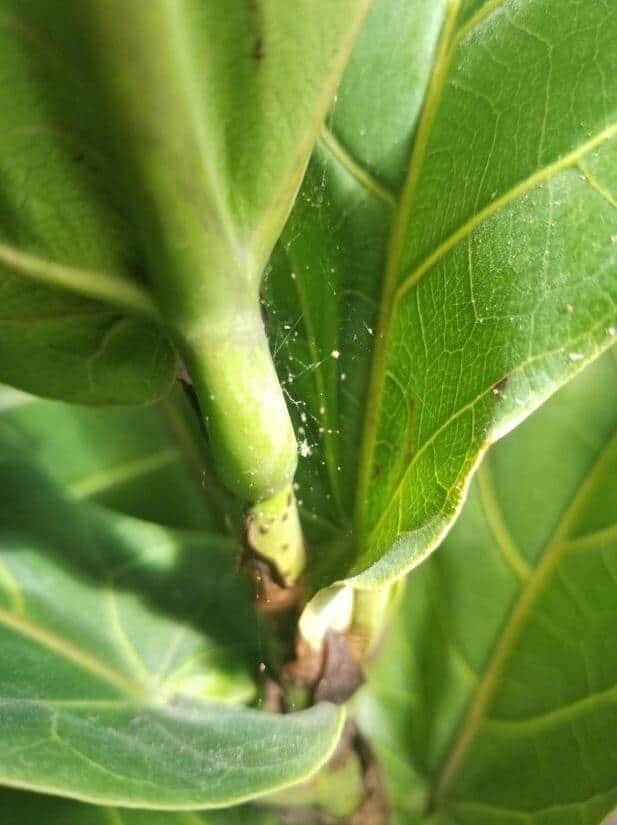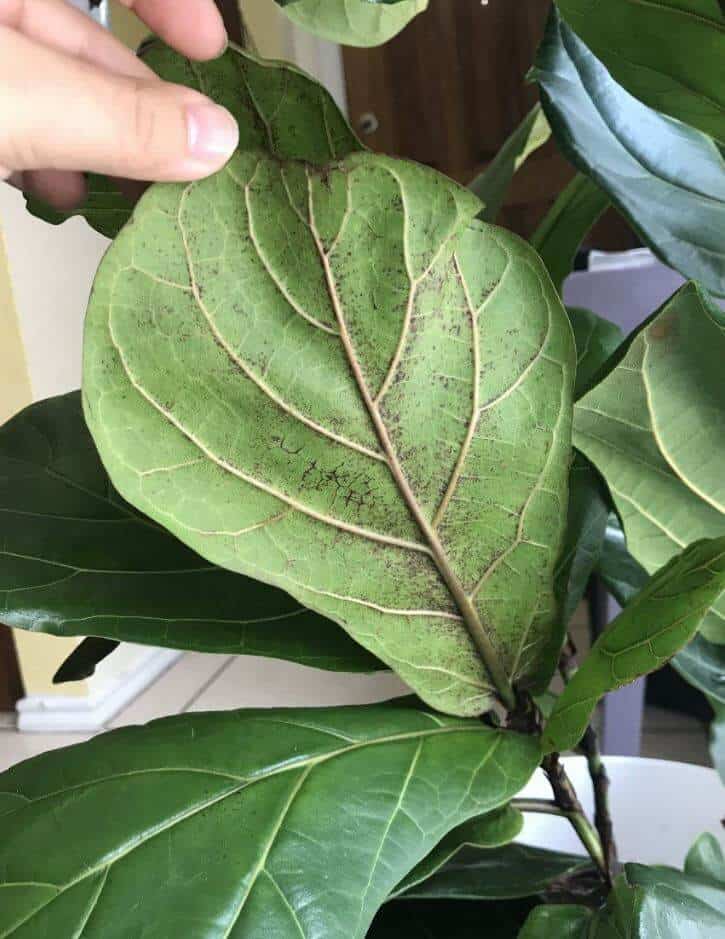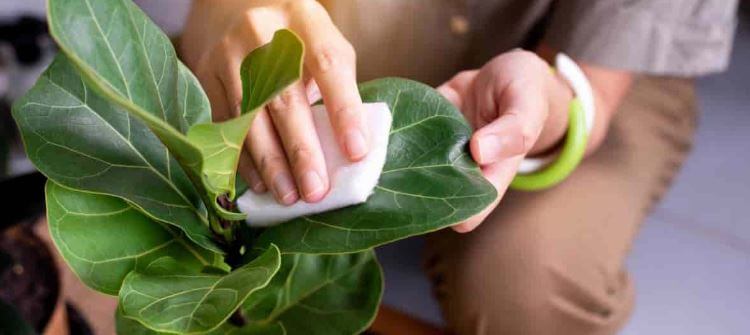Last Updated on May 30, 2023 by a Friendly Gardener
Fiddle figs can grow to be striking, lush indoor plants, but they also can become havens for spider mites. These pests are common to many indoor houseplants, so it isn’t surprising that they may decide to visit your Fiddle Leaf fig.
Fiddle leaf figs are susceptible to spider mite infestations, and when left untreated, these infestations can cause yellowing foliage, stunted growth, and become fatal in severe cases. Think you have a spider mite problem? Here’s what you can do about it.
Why Spider Mites Visit Fiddle Leaf Figs

Spider mites prefer houseplants that do not retain much water, especially those plants that are not overwatered. They thrive in hot, dry environments. The warmer summer months are ideal for them to proliferate, so you may end up with a significant number of these pesky insects and they can spread quickly to other plants. A gardening tool, a breeze, or the nearness of an infested plant can lead to your entire indoor garden becoming infested.
Spider mites particularly enjoy feeding on Fiddle Leaf fig foliage. They can do quite a bit of damage to your plant because they reproduce so quickly. If a spider mite infestation is not resolved, it can overwhelm and destroy your plant.
Underwatered, dry plant environments are perfect for them. There are several signs that you can look for confirmation that you may have a spider mite infestation.
-
Cottony webbing

If you see spider webs, the fiddle leaf fig spider mites are out and about. You may find webbing on foliage or near it. Webbing is a sure sign that you have an infestation. These webs host clumps of eggs, so if they are present, your plant already suffers from a severe infestation.
-
Crinkly discolored leaves
Spider mites are sap suckers, so they feed on the foliage. As they feed on leaves that contain chlorophyll, the leaves will begin to lose their coloring, and yellow or brown spots will appear. This is a sign that the spider mites have already feasted on this part of your plant. As they proliferate so rapidly, within several days, your plant may become heavily damaged.
Yellowing foliage also points to a potential spider mite infestation. First leaves will weaken, yellow, and then begin to drop off. At this point, it may be too late to save your Fiddle Leaf Fig.
-
Tiny spots on foliage
White, yellow, or brown spotting of minuscule dimensions is another symptom of a spider mite presence. Under close examination, you may note that the spots are moving. Examine closely the undersides of the leaves.
Spider mites on fiddle leaf fig can be attracted by over-fertilization. While nutrients are essential to a plant’s health, excessive fertilization especially containing nitrogen can render your Fiddle Leaf Fig sweeter, thus tastier for sap suckers like spider mites.
If you are unable to see the mites as they are indeed tiny, place a piece of white paper under the leaves and shake your plant. If you see specks moving about on the paper, you have a spider mite infestation.
If you find signs of a spider mite infestation, your Fiddle Leaf Fig must be immediately isolated from any other houseplants you may have so that you don’t end up with all your plants being affected.
How to Treat Spider Mites on Fiddle Leaf Fig

There are several remedies for these fiddle leaf fig pests. If your plant is already suffering, treatment is necessary to save it and prevent the spread of the colony. Which treatment you select and how often you apply it will depend on the severity of damage to the plant.
Water Jet Sprays
If you can take our plant outside or use a high-pressure shower spray indoors, this is one way to eliminate spider mites from plants. Spray affected plant areas and the water will remove the mites. Spider mites hate water because it is lethal to them. Do take care about the amount of force used to not damage the plant further.
Neem Oil

Also referred to as margosa oil, Neem oil is a favorite among gardeners as it is an organic horticultural oil. It will not negatively affect healthy parts of the plant and can eliminate spider mites at any stage of their life cycle whether adults or eggs. Neem oil can be purchased ready-to-use from nurseries and garden centers, or it can be added to a mix of water and mild dish detergent. Add two teaspoons of dish detergent to a gallon of water and mix. Then add three tablespoons of neem oil and mix well. Place in a spray bottle and spray the plant or its affected parts. Spray generously until the leaves are wet. Repeat this for a couple of weeks. If your fig is outside on a porch or receives direct sunlight indoors, it is best to apply neem oil in the late afternoon when the sunlight has weakened so that foliage is not at risk for burning.
Fiddle Leaf Fig Pesticide
Nursery and garden centers will carry a variety of chemical pesticides that will treat spider mites on fiddle leaf figs. Each commercial pesticide will have a different chemical formula, so it’s important to follow directions as to how it should be applied.
Insecticidal Soap
Insecticidal soap is a soap-based formula that rids plants of pest infestations. It can be purchased or made at home. You can prepare your insecticidal soap by mixing 2.5 tablespoons of dishwashing soap (liquid) with 2.5 tablespoons of vegetable oil and one gallon of warm water. Shake to mix thoroughly and then spray your soap formula directly on the infested parts and the soil bed. Apply until there are no more signs of a spider mite infestation.
Alcohol

Dampen a cotton ball or pad or dip a swab into alcohol and clean the foliage of your plant. Do this only on mature foliage as young leaves may be damaged with this solution. If you prefer to spray your plant, prepare a spray that is one part alcohol and three parts water. Mix and spray.
In Conclusion
Sap-sucking spider mites are a threat to foliage in general, and they are attracted to fiddle leaf figs. They proliferate rapidly, so your plant may be overrun in a very short amount of time. To contrast spider mite infestations, keep your plant clean, trimmed, and well-hydrated. Examine your plant regularly for signs of a spider mite presence and intervene immediately if you suspect you have an infestation. Isolate your fiddle leaf fig if infested and treat immediately until all signs of infestation have been eliminated.


